Healthy Facilities
HEALTHY SCHOOLS = CARING. The Healthy Facilities Institute (HFI), in partnership with School Planning & Management and College Planning & Management magazines, proudly acknowledge the thousands of caring individuals that work in the nation’s public and private schools.
While hundreds of schools could be winners, we wish to highlight the standouts, based on applications received in 2017.
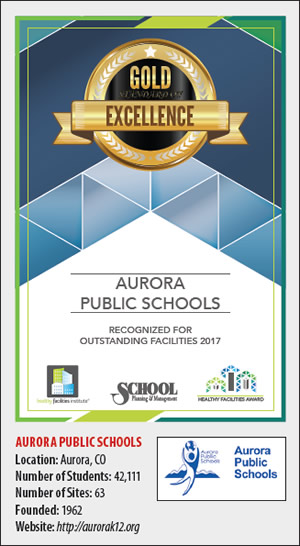 Aurora Public Schools (APS) received the Gold Standard of Excellence recognition for its district-wide holistic approach to healthy indoor environments:
Aurora Public Schools (APS) received the Gold Standard of Excellence recognition for its district-wide holistic approach to healthy indoor environments:
• Piloting full-spectrum lighting using special roof-mounted tubing with light-gathering lenses that direct natural sunlight (minus harmful UV) into the learning spaces.
• Pioneering ergonomic stools that promote active sitting; the convex and non-slip base of “wobbly” stools allows student movement which helps with blood circulation and mental engagement.
• Testing drinking water to avoid lead and other exposures; in one case, exceeding the regulatory requirement. For example, setting the lead standard to not more than 15 parts per billion (ppb) versus 20 ppb. Also, APS provides more than 20 hydration stations with bottle fillers to encourage students to drink water.
• Using deep cleaning, spray-and-vac restroom machines to remove soil and microbes that may cause illness or odor. This has decreased labor hours by 15 percent and chemical use by 10 percent at the introductory sites.
• Using mostly Green Seal Certified Cleaners (80 percent of chemicals used) and an advanced chemical dilution and dispensing system to fill solution receptacles. Precise chemical dilution saves money, enhances performance and safety.
• Providing at least 8 to 12 feet of matting at site entrances.
• Moving Integrated Pest Management (IPM) in-house by hiring a former contract professional, saving the district money while improving program quality and reducing chemical use. Adopting simple methods such as installing door-bottom sweeps to keep pests out.
• Creating communication loops to help custodial, environmental and maintenance teams, plus teaching and administrative staff, work together, contributing to the success of health-related programs.
• Teaching custodians health and safety in APS’s Custodial 101, Custodial Leadership Academy, Custodial Safety Handbook and Custodial Procedural Handbook. Topics covered include: Safety Data Sheets (SDS), Personal Protective Equipment (PPE), waste handling and disposal, hazardous materials, the chain of infection, right to know, chemical safety and chemical dilution.
• APS’s Environmental Department (ED) works with teachers to promote safe practices and maintain a database for chemical inventory. The ED conducts annual site inspections with science and art teachers to prevent chemical exposures and promote proper handling, storage and disposal of chemicals.
• The APS Natural & Renewable Resources Department supports “green teams” consisting of schools and student groups focused on making schools and communities more environmentally aware. One goal is to empower K-12 students to become change-agents. Students use school buildings to research solutions, conduct analyses, document experiments and forge partnerships with industry.
• APS Programs have been recognized by the EPA (Region 8) and the USDA. Awards include:
- Colorado Alliance for Environmental Education Innovation Award for 2017
- City of Aurora’s Sustainable Business Award for 2016
- Bronze Achievement by the Colorado Dept. of Public Health and Environment’s Environmental Leadership Program for 2016
- USGBC Colorado Chapter’s 2015 Commercial Real Estate Award for Most Successful Community Engagement Award
• Using video monitoring at entrances for security, plus ongoing training and practice scenario drills, and a security infrastructure covering 66 sites and 1,550 security cameras monitored 24/7. APS uses proximity cards for controlled access, transportation GPS technology and RFID passes for tracking and monitoring elementary school bus riders.
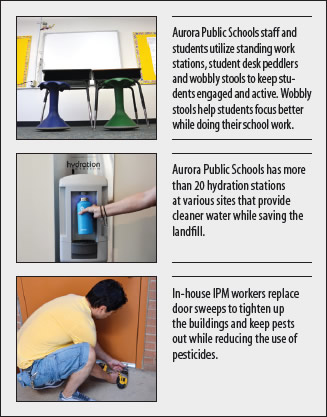
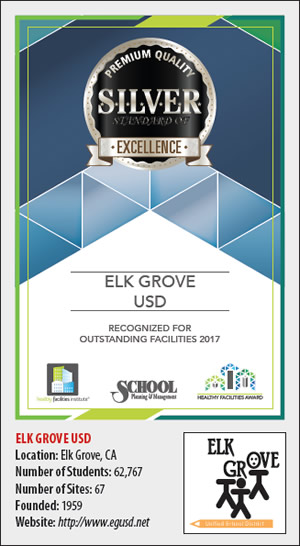 Elk Grove USD (EGUSD) received the Silver Standard of Excellence recognition for its district-wide commitment to a better indoor environment:
Elk Grove USD (EGUSD) received the Silver Standard of Excellence recognition for its district-wide commitment to a better indoor environment:
• Each Classroom has an HVAC unit and MERV 8 filters are routinely changed every three months. In ceramic and carpentry shops, filters are changed monthly.
• Acoustic tiles are used throughout. Most HVAC units are located on the roof, not near windows and doors.
• Classrooms are cleaned and vacuumed daily. Fragrant oils, sprays, etc. are strongly discouraged in rooms. Fragrant shrubs and trees are planted away from classroom doors and windows. EGUSD uses walk-off matting in each room to reduce walkedin contamination. They also use Green Seal-approved products, often hydrogenperoxide based, and, increasingly, OSG (on-site generation) of ElectroChemically Activated Solutions. Making their own solutions saves money, and reduces common chemical exposures.
• The district has formed a standing committee to assess the effect of pollutants and chemicals on asthma, allergies and other breathing problems.
• EGUSD uses diamond-polishing of concrete in several areas to eliminate chemically intensive maintenance.
• EGUSD provides M&O employees a $160 credit for steel-toed footwear.
• Water fountains are in most classrooms. Water-vending machines are in middle and high school campuses. Many office areas have water filters connected to faucets.
• EGUSD has a detailed IPM program that is a part of staff training.
• EGUSD has moved to alternative treatments for burrowing rodents that include non-bait methods such as CO2 and habitat modification.
• EGUSD has protected insect pollinators by harvesting eight honey bee swarms in the last two years. These were turned over to local bee keepers.
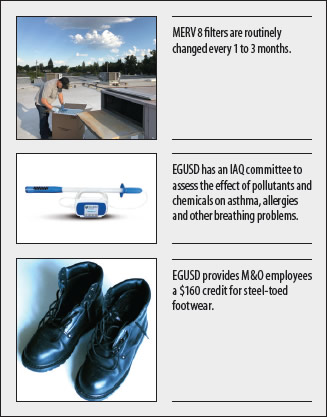
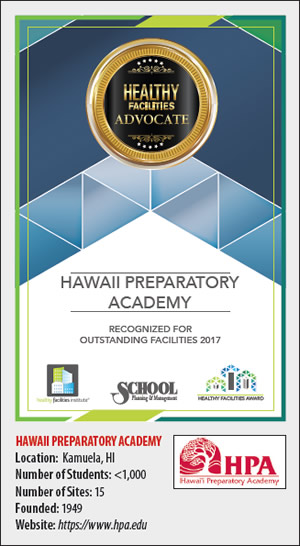 Hawaii Preparatory Academy (HPA) received the Healthy Facilities Advocate recognition for its mission to promote healthful, place-based learning on a site with access to 80 percent of the world’s ecosystems:
Hawaii Preparatory Academy (HPA) received the Healthy Facilities Advocate recognition for its mission to promote healthful, place-based learning on a site with access to 80 percent of the world’s ecosystems:
• HPA monitors the indoor environment using devices that detect carbon dioxide, temperature and sound levels.
• HPA makes standing desks and anti-fatigue mats available to teachers.
• HPA uses dry steam vapor for cleaning and disinfecting, and a hydrogen peroxide-based cleaner, having reduced annual spending on chemical cleaners by nearly $4,000.
• HPA uses a low-toxicity plant-based intervention to control insects.
• The HPA Energy Lab achieved Living Building Challenge Certification by the International Living Building Institute (ILBI), and was also awarded Platinum-level LEED (Leadership in Energy and Environmental Design) for Schools 2.0 certification by the U.S. Green Building Council.
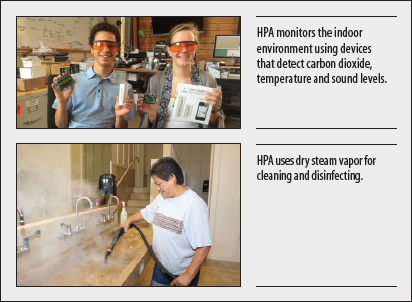
This article originally appeared in the issue of .